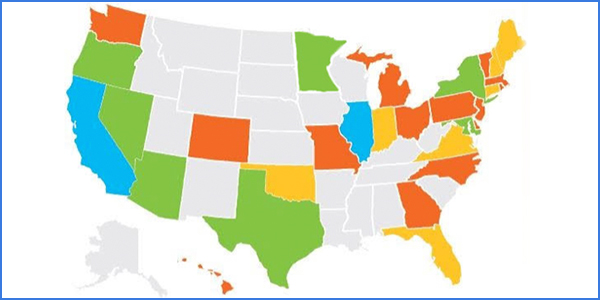By Rich Heidorn Jr.
WASHINGTON — California and Illinois won the top spots on the GridWise Alliance’s fifth annual Grid Modernization Index, standing out for their initiatives on energy storage, distributed generation, non-wires alternatives and ratemaking innovations.
Minnesota jumped to 10th place from 21st, and Colorado also jumped several spots to No. 11 in the index, which ranks states and D.C. on policies, customer engagement (rate structures, customer outreach and data collection practices) and grid operations (deployment of technologies such as sensors and smart meters).
GridWise announced the results at the gridConnext 2018 conference, where attendees heard about some of the projects exciting grid technology advocates.
‘Trailblazer’

GridWise CEO Steve Hauser said California “continues to be the grid modernization trailblazer,” citing its distribution system planning requirements and “multi-pronged approach to support distributed energy resources, including competitive solicitations, multiple DER demo projects, a self-generation incentive program, a net metering tariff, and an energy storage target and default time-of-use rates.”
Speaking at the conference, Courtney Prideaux Smith, chief deputy director of the California Energy Commission, noted that the CEC had just received approval to implement a requirement that new homes include solar panels beginning in 2020.
The new standards require that the solar systems be sized to meet each home’s energy usage and encourage battery storage and heat pump water heaters. The CEC says the new rules and other energy-efficiency initiatives will reduce energy use in new homes by more than 50%.
“It is going to save Californians money starting on day one,” Smith said.
Smith also touted the microgrid developments in the state, citing Borrego Springs, a desert community 90 miles east of San Diego that sits at the end of a transmission line, where frequent outages can leave elderly residents without air conditioning.
After a wildfire knocked out the line in 2007, San Diego Gas & Electric applied for a grant to create what Smith said is one of the world’s largest utility-owned microgrids, which integrates generation and storage and has reduced the community’s greenhouse gas emissions by 20%.
When lightning and flooding knocked out the transmission line again in 2013, Smith said, “the microgrid did exactly what we wanted it to. It islanded, and it directed power to critical infrastructure” — a gas station, a library that served as a cooling center for those who couldn’t relocate, and an elderly community.
Smith also cited a tenant-owned mobile home park in Bakersfield where the state helped add solar power with storage, reducing the low-income community’s net energy consumption by 30%.
Cluster of Microgrids

Anne Pramaggiore, who oversees Exelon’s six utilities, told the conference about a pilot to build “the world’s first microgrid cluster,” which will connect a solar-powered microgrid in the Bronzeville neighborhood of Chicago to an existing microgrid at the Illinois Institute of Technology. The project was approved by the Illinois Commerce Committee in February.
Solar panels located on a Chicago Housing Authority building will provide power to both the building residents and the microgrid. The plan also includes a “first-mile, last-mile” electric vehicle rideshare program for senior citizens and solar- and battery-powered lighting in areas without streetlights, a STEM education program at local schools, and an energy-efficiency program.
Pramaggiore said Exelon’s utilities also are “beginning to make investments to accelerate the conversion of distribution circuits from 4 kV to 12 kV to accommodate more distributed generation; build[ing] out smart inverters to better integrate diverse resources into the grid; … [and] standing up hosting capacity maps to help customers and developers see where the grid has capacity for solar.”
GridWise also cited the ICC’s approval of an order allowing utilities to recover the costs of cloud-based computing services “seen by many observers as a key pathway to move toward a service orientation (versus the traditional infrastructure focus core to most regulatory regimes).”
Ohio and Rhode Island Cited
GridWise gave Outstanding Progress Awards to Ohio and Rhode Island for recent initiatives.
The Public Utilities Commission of Ohio is pursuing regulatory changes “to support innovation while envisioning the distribution grid as an open-access platform enabling various levels of customer engagement,” GridWise said.
The group said Rhode Island regulators addressed their changing distribution system with new rate design principles and a benefit-cost framework.







